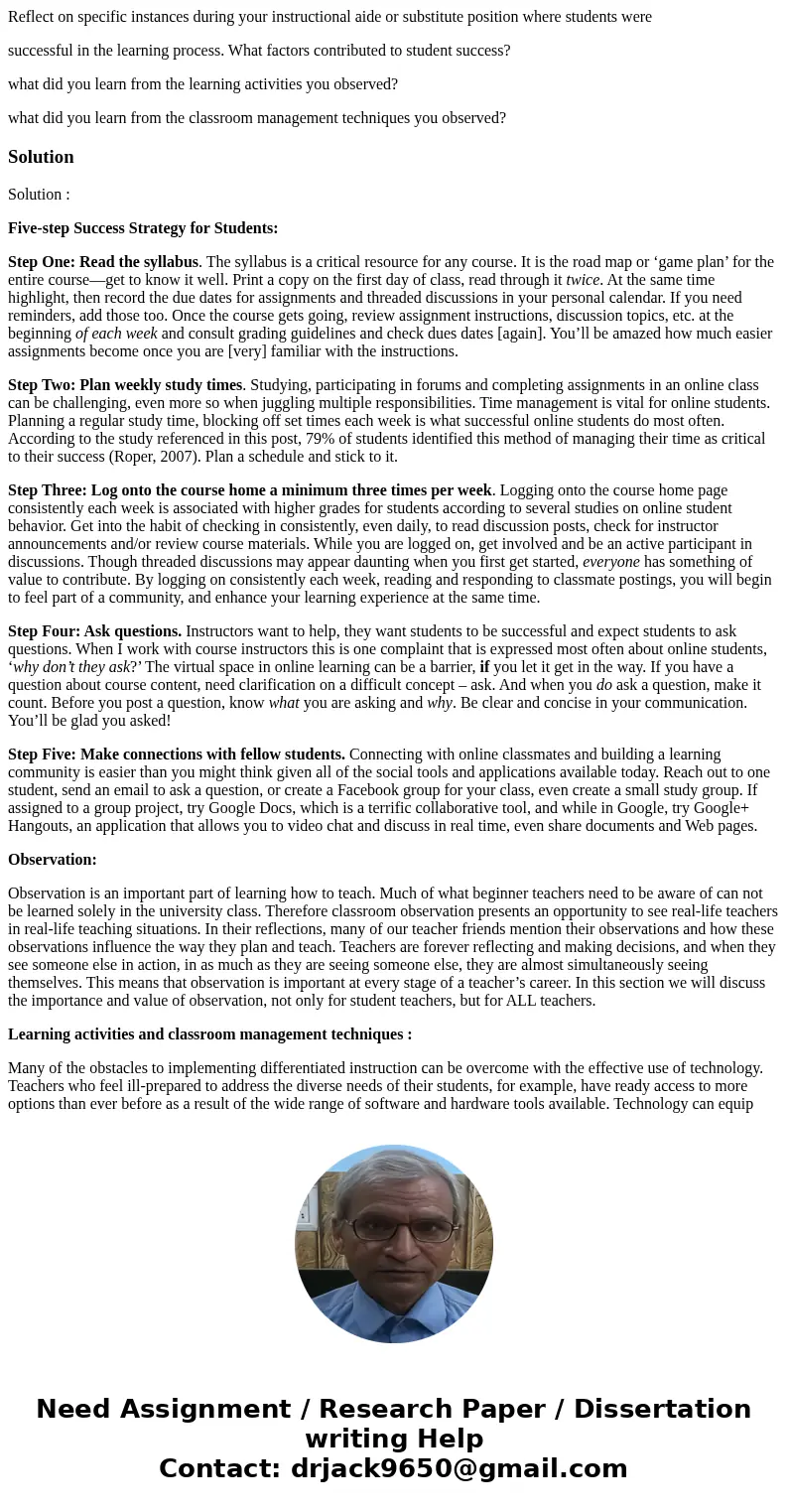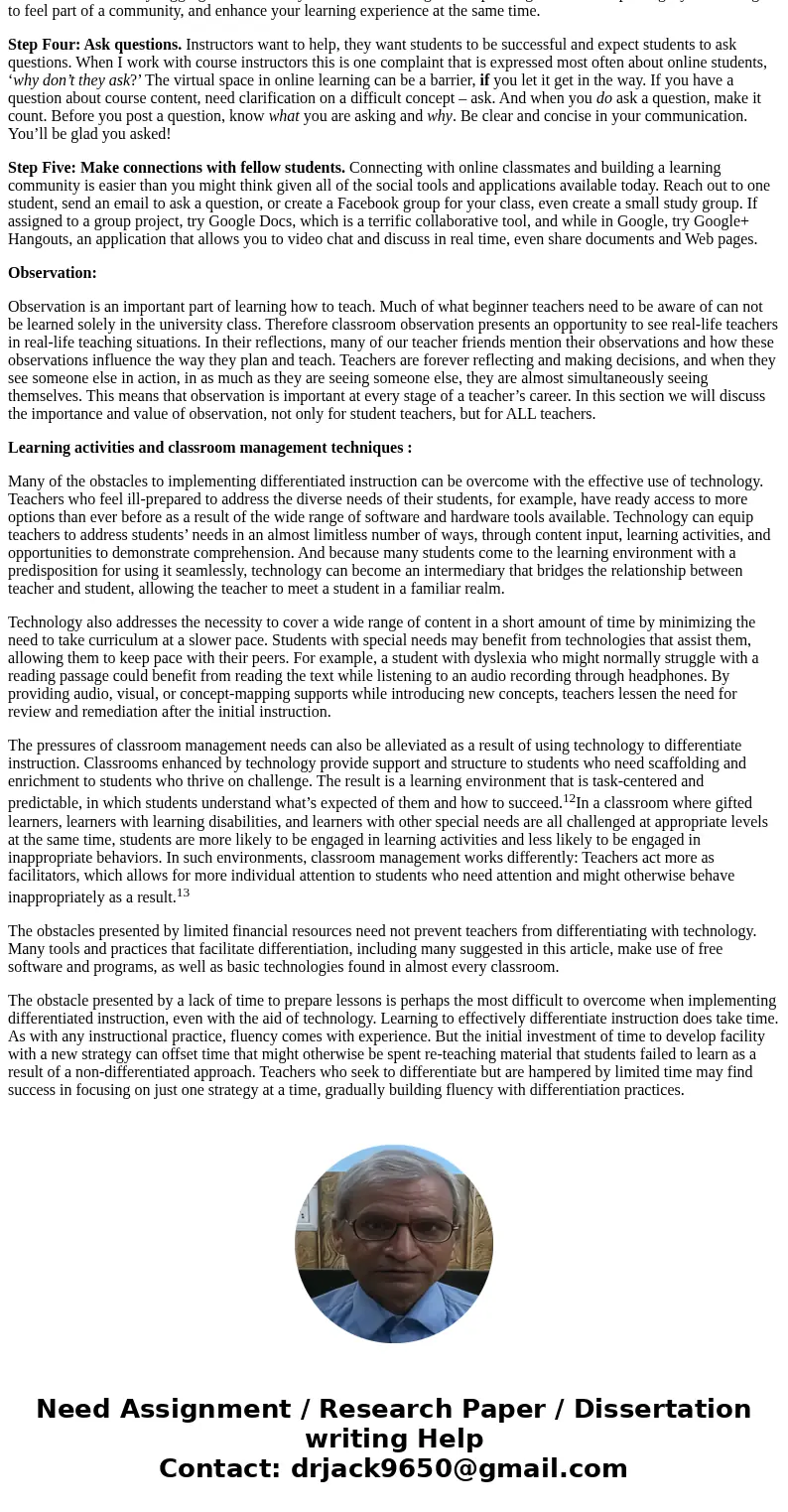Reflect on specific instances during your instructional aide
Reflect on specific instances during your instructional aide or substitute position where students were
successful in the learning process. What factors contributed to student success?
what did you learn from the learning activities you observed?
what did you learn from the classroom management techniques you observed?
Solution
Solution :
Five-step Success Strategy for Students:
Step One: Read the syllabus. The syllabus is a critical resource for any course. It is the road map or ‘game plan’ for the entire course—get to know it well. Print a copy on the first day of class, read through it twice. At the same time highlight, then record the due dates for assignments and threaded discussions in your personal calendar. If you need reminders, add those too. Once the course gets going, review assignment instructions, discussion topics, etc. at the beginning of each week and consult grading guidelines and check dues dates [again]. You’ll be amazed how much easier assignments become once you are [very] familiar with the instructions.
Step Two: Plan weekly study times. Studying, participating in forums and completing assignments in an online class can be challenging, even more so when juggling multiple responsibilities. Time management is vital for online students. Planning a regular study time, blocking off set times each week is what successful online students do most often. According to the study referenced in this post, 79% of students identified this method of managing their time as critical to their success (Roper, 2007). Plan a schedule and stick to it.
Step Three: Log onto the course home a minimum three times per week. Logging onto the course home page consistently each week is associated with higher grades for students according to several studies on online student behavior. Get into the habit of checking in consistently, even daily, to read discussion posts, check for instructor announcements and/or review course materials. While you are logged on, get involved and be an active participant in discussions. Though threaded discussions may appear daunting when you first get started, everyone has something of value to contribute. By logging on consistently each week, reading and responding to classmate postings, you will begin to feel part of a community, and enhance your learning experience at the same time.
Step Four: Ask questions. Instructors want to help, they want students to be successful and expect students to ask questions. When I work with course instructors this is one complaint that is expressed most often about online students, ‘why don’t they ask?’ The virtual space in online learning can be a barrier, if you let it get in the way. If you have a question about course content, need clarification on a difficult concept – ask. And when you do ask a question, make it count. Before you post a question, know what you are asking and why. Be clear and concise in your communication. You’ll be glad you asked!
Step Five: Make connections with fellow students. Connecting with online classmates and building a learning community is easier than you might think given all of the social tools and applications available today. Reach out to one student, send an email to ask a question, or create a Facebook group for your class, even create a small study group. If assigned to a group project, try Google Docs, which is a terrific collaborative tool, and while in Google, try Google+ Hangouts, an application that allows you to video chat and discuss in real time, even share documents and Web pages.
Observation:
Observation is an important part of learning how to teach. Much of what beginner teachers need to be aware of can not be learned solely in the university class. Therefore classroom observation presents an opportunity to see real-life teachers in real-life teaching situations. In their reflections, many of our teacher friends mention their observations and how these observations influence the way they plan and teach. Teachers are forever reflecting and making decisions, and when they see someone else in action, in as much as they are seeing someone else, they are almost simultaneously seeing themselves. This means that observation is important at every stage of a teacher’s career. In this section we will discuss the importance and value of observation, not only for student teachers, but for ALL teachers.
Learning activities and classroom management techniques :
Many of the obstacles to implementing differentiated instruction can be overcome with the effective use of technology. Teachers who feel ill-prepared to address the diverse needs of their students, for example, have ready access to more options than ever before as a result of the wide range of software and hardware tools available. Technology can equip teachers to address students’ needs in an almost limitless number of ways, through content input, learning activities, and opportunities to demonstrate comprehension. And because many students come to the learning environment with a predisposition for using it seamlessly, technology can become an intermediary that bridges the relationship between teacher and student, allowing the teacher to meet a student in a familiar realm.
Technology also addresses the necessity to cover a wide range of content in a short amount of time by minimizing the need to take curriculum at a slower pace. Students with special needs may benefit from technologies that assist them, allowing them to keep pace with their peers. For example, a student with dyslexia who might normally struggle with a reading passage could benefit from reading the text while listening to an audio recording through headphones. By providing audio, visual, or concept-mapping supports while introducing new concepts, teachers lessen the need for review and remediation after the initial instruction.
The pressures of classroom management needs can also be alleviated as a result of using technology to differentiate instruction. Classrooms enhanced by technology provide support and structure to students who need scaffolding and enrichment to students who thrive on challenge. The result is a learning environment that is task-centered and predictable, in which students understand what’s expected of them and how to succeed.12In a classroom where gifted learners, learners with learning disabilities, and learners with other special needs are all challenged at appropriate levels at the same time, students are more likely to be engaged in learning activities and less likely to be engaged in inappropriate behaviors. In such environments, classroom management works differently: Teachers act more as facilitators, which allows for more individual attention to students who need attention and might otherwise behave inappropriately as a result.13
The obstacles presented by limited financial resources need not prevent teachers from differentiating with technology. Many tools and practices that facilitate differentiation, including many suggested in this article, make use of free software and programs, as well as basic technologies found in almost every classroom.
The obstacle presented by a lack of time to prepare lessons is perhaps the most difficult to overcome when implementing differentiated instruction, even with the aid of technology. Learning to effectively differentiate instruction does take time. As with any instructional practice, fluency comes with experience. But the initial investment of time to develop facility with a new strategy can offset time that might otherwise be spent re-teaching material that students failed to learn as a result of a non-differentiated approach. Teachers who seek to differentiate but are hampered by limited time may find success in focusing on just one strategy at a time, gradually building fluency with differentiation practices.


 Homework Sourse
Homework Sourse